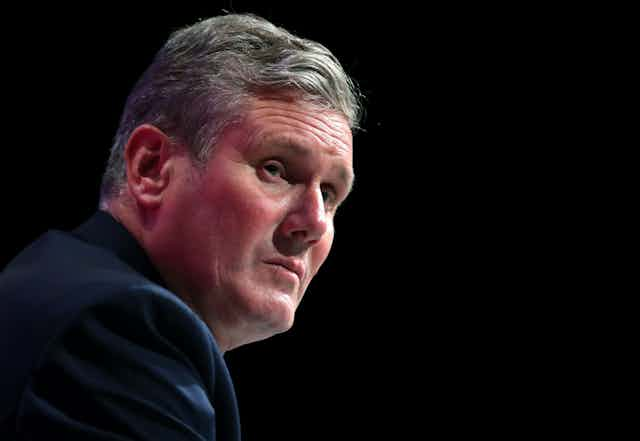The Labour party has voted to amend the rules governing how it elects leaders at its 2021 party conference. This was a marker successfully laid down by current leader Keir Starmer – but one that only came after a battle with the Labour left.
Disputes over the rule change show that friction continues within the party. The internal debates dominated the headlines when Labour should have been showcasing its policies.
At conference, Starmer presented a package of reforms, the most significant of which is that anyone wanting to stand for the leadership must first win the backing of 20% of Labour members of parliament – rather than the current 10%. This ensures that any future leader has the support of the Parliamentary Labour Party, after several difficult years between MPs and the leadership.
Starmer had originally attempted to turn back the clock and reintroduce an electoral college – a system that had operated prior to 2014. This split into thirds the proportion of votes cast at leadership elections between Labour MPs, local members, and the trade unions. But when the proposals appeared likely to be defeated, Starmer’s supporters pushed for the 20% threshold to act as a gatekeeper for future leadership elections.

These reforms passed with 53.7% in favour. Starmer commented that the changes were “a crucial step forward for the party.”
Who was against the move?
Starmer’s changes were roundly opposed by the left within the union movement and the constituencies. It was their forceful response at a meeting with trade unions two days prior to the vote that forced the shift away from the electoral college plan. The general secretary of Unite, Sharon Graham, had called the initial plans “unfair, undemocratic and a backward step.”
Several unions even voted against the watered down 20% proposal, presumably fearing for the chances of any left-wing candidate gaining sufficient support to stand at a future leadership election. The Fire Brigades Union and the Communications Workers’ Union spoke against the reforms on the conference floor. Yet, crucially for Starmer, UNISON recommended that its delegates should vote in favour of the changes.
Outside of the union movement, influential left-wing campaign group Momentum also opposed the rule change, which it described as a “self-inflicted blow to democracy”.
But more broadly, and perhaps more concerningly for Starmer, the mayor of Manchester, Andy Burnham, signalled his opposition to the changes, arguing it was the wrong time to change the rules as “people are not interested in the minutiae of rule changes in political parties”. In a similar vein, allies of Labour’s deputy leader Angela Rayner also indicated that she was furious that Starmer had forced the conference to be hijacked by leadership rule changes. Burnham and Rayner have each been touted as potential challengers to Starmer’s leadership.
Closing multiple chapters
Further rule changes appear to have the past few years of turmoil in mind, too. It will now be more difficult for local Labour parties to deselect their MPs in the run up to general elections – a threat at times made against MPs who opposed Corbyn.
People will no longer be able to pay £25 to vote in leadership elections as a “registered supporter” without having to take out full party membership. And anyone hoping to vote as a member will have to have joined six months prior to any leadership election, ending any prospect of people joining the party just to pick the leader. This is seen as removing a key support base for the left since these mechanisms played an important role in Corybn’s path to the leadership in 2015.
Worth the risk?
Taking on the unions in this way was a big risk. Starmer could have lost a key battle. So why did he take the gamble?
In simple terms, it now appears highly unlikely that any left-wing figure could drum up the support of 20% of the Parliamentary Labour Party to stand at a future leadership election. Based on Labour’s current 199 MPs, future contenders for the party leadership would now need to secure the support of 40 MPs. From the left, Rebecca Long-Bailey (in 2020), Jeremy Corbyn (in 2015), Diane Abbott (in 2010) would all have failed to make the ballot under a 20% threshold. Yet, opponents of the change argued that the new rule would also have precluded centre-left figures such as Lisa Nandy (in 2020), Liz Kendall (in 2015), Ed Balls and Andy Burnham (in 2010) and Margaret Beckett and John Prescott (in 1994) from joining the ballot.
Indeed, Momentum commented: “If the 20% threshold applied to the 2020 leadership election it would have been a contest between Sir Keir Starmer QC and Sir Keir Starmer QC”.
Beyond the impact at future leadership elections, Starmer also appears to have been seeking a “Clause IV moment”. Famously, Neil Kinnock took on Militant in 1985, John Smith secured One Member, One Vote within the trade union section in 1993, Tony Blair revised Clause IV in 1995, and Ed Miliband removed the electoral college in 2014. Such changes have been watershed moments in Labour history as successive leaders stamped their authority on the party.
But this doesn’t appear to have come off. Instead of signalling a new dawn, Starmer has re-emphasised Labour’s divides. He has spent much of his energy at his first in-person conference as leader focusing on internal issues that will have more importance for any of his successors than for him. Whilst the changes to Labour’s leadership contest may ensure a centre-left future for the party, they won’t do anything to help his own electoral chances.
This article has been updated to reflect that UNISON members voted in favour of the leadership election rule changes. It originally stated that they were encouraged to abstain.

